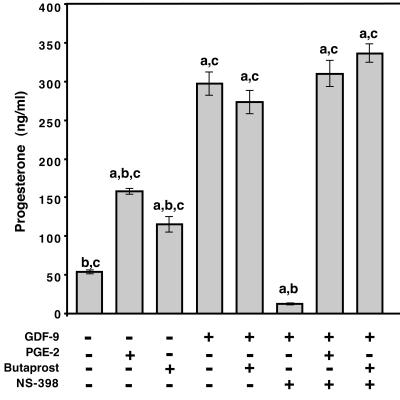Figure 4.
GDF-9 stimulated progesterone production depends on prostaglandin synthesis and requires an EP2 receptor pathway. Progesterone production by granulosa cells treated with GDF-9 (100 ng/ml), PGE2 (500 ng/ml), butaprost (10 μM), and/or NS-298 (1 μM) after 24 h of culture. PGE2 and butaprost stimulate progesterone production to similar levels, and GDF-9 is approximately twice as effective at the concentrations used. Butaprost plus GDF-9 is equally effective as GDF-9 alone, suggesting that these two ligands are in the same pathway. NS-398 reduces the progesterone levels to less than baseline levels, and PGE2 or butaprost alone overrides the NS-398 block (data not shown). The production of progesterone by GDF-9 is blocked equally by NS-398 or indomethacin (data not shown) and restored by PGE2 or butaprost. Values are mean ± SEM for triplicate samples. The experiment was repeated on several occasions with different ligand concentrations resulting in similar outcomes. a, P < 0.05 compared with control (no ligand); b, P < 0.05 compared with GDF-9 treatment; c, P < 0.05 compared with GDF-9 plus NS-398 treatment.

